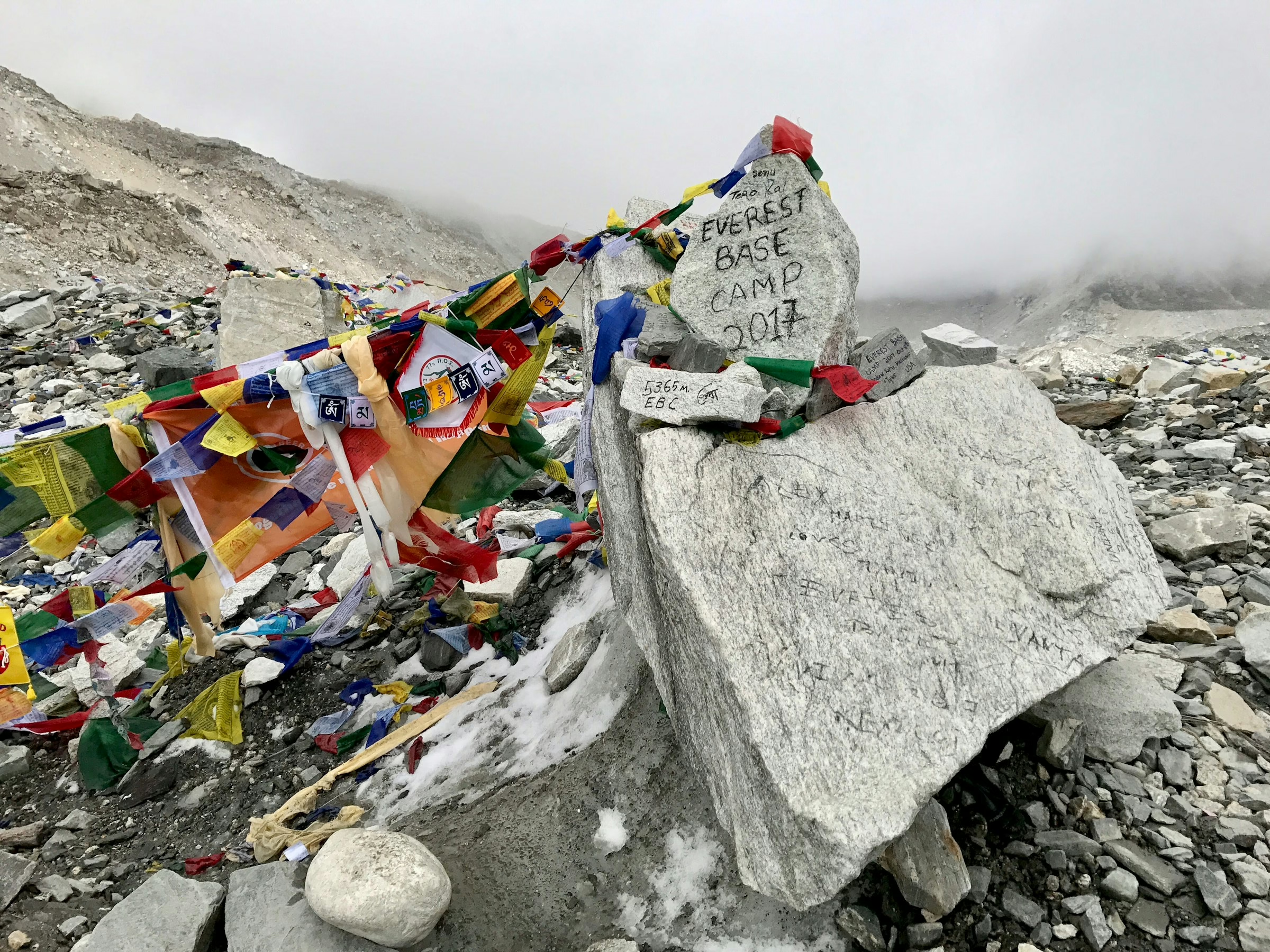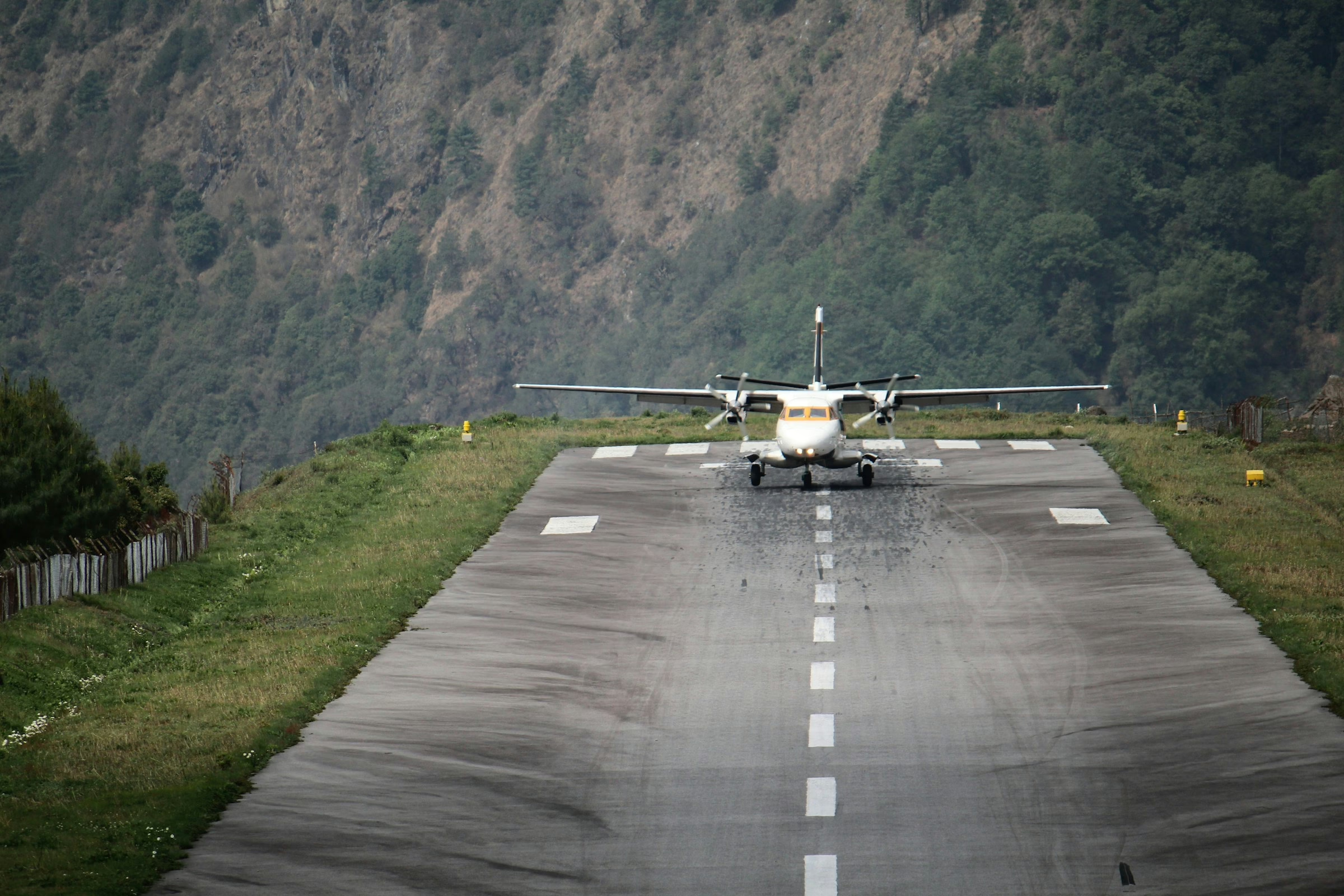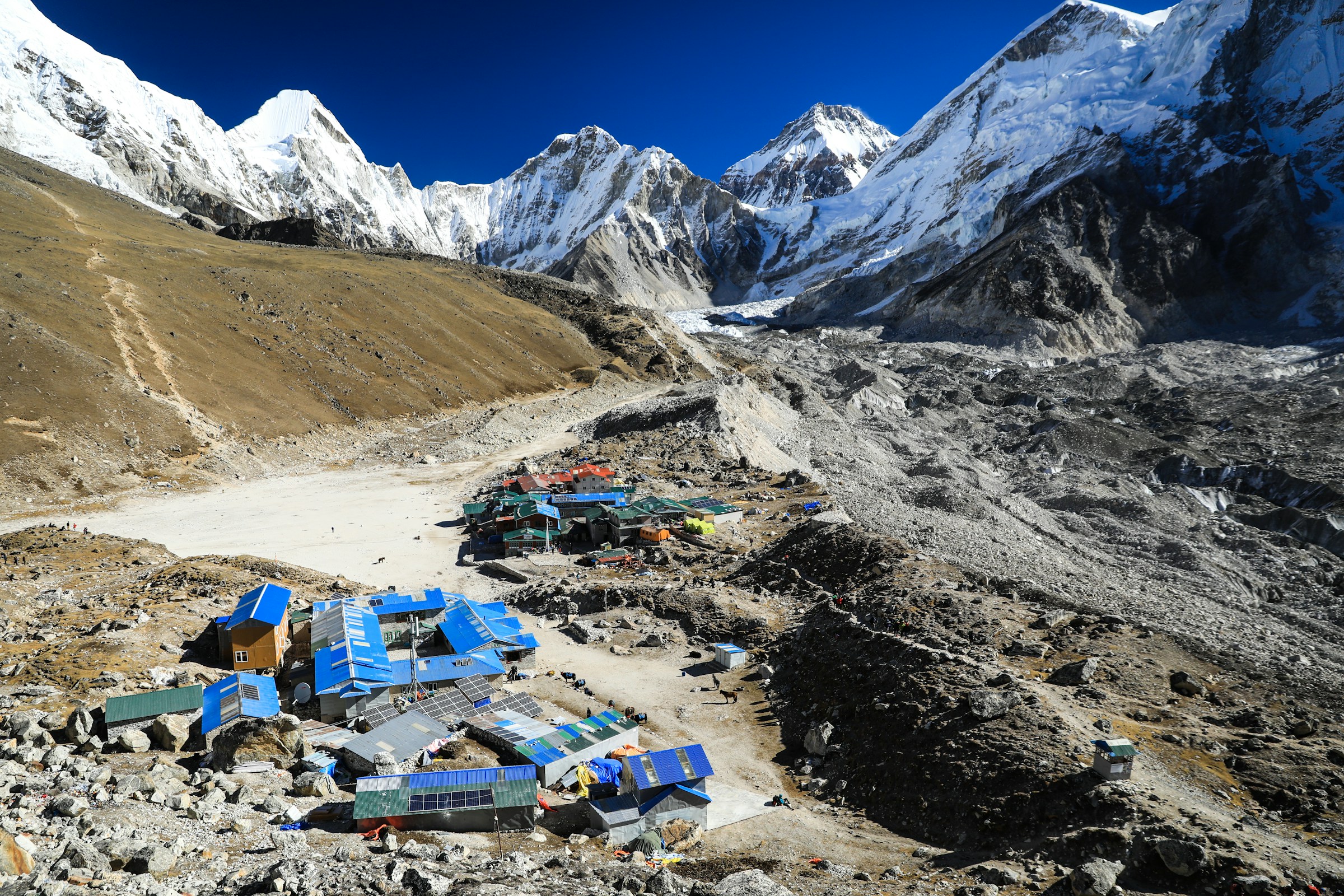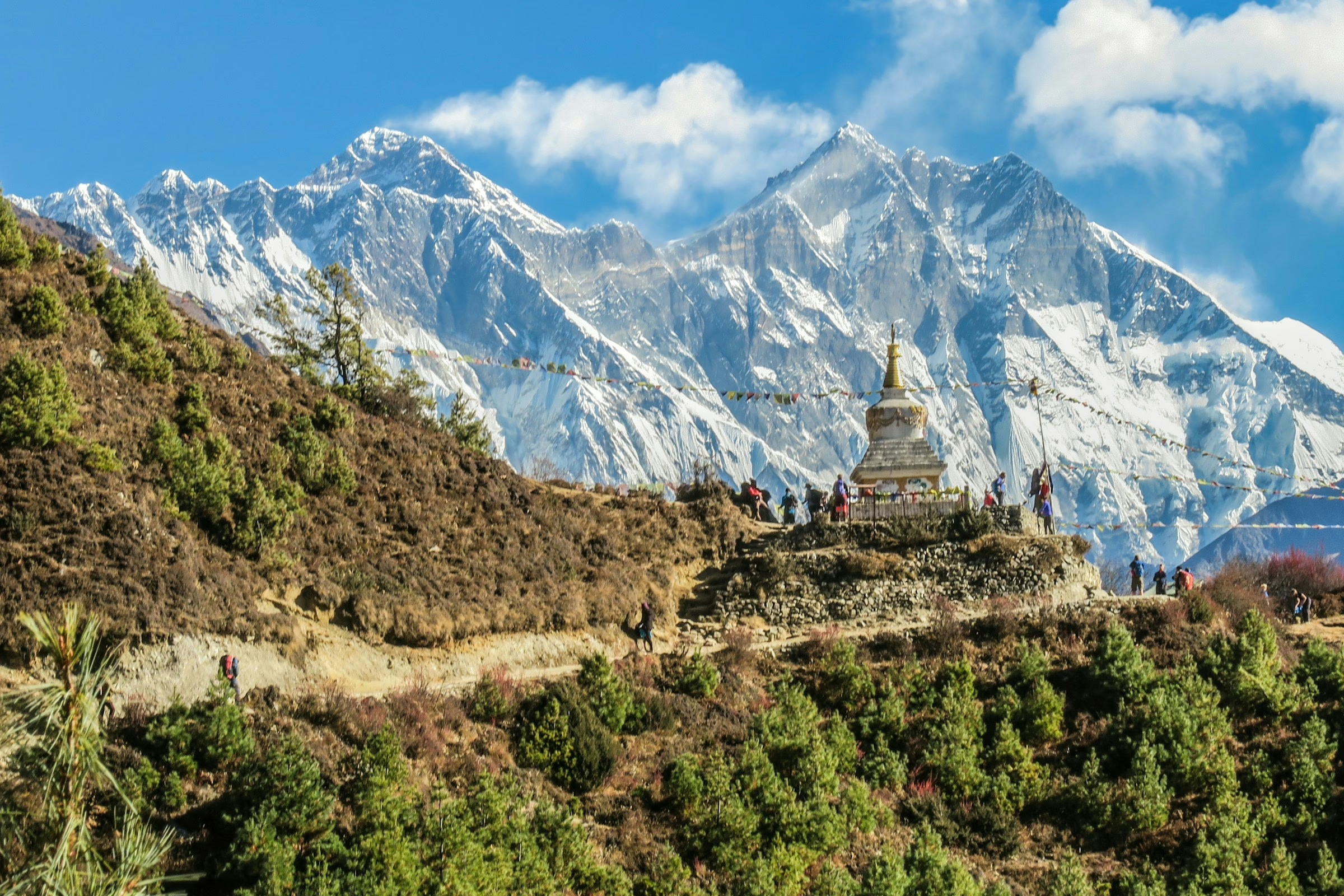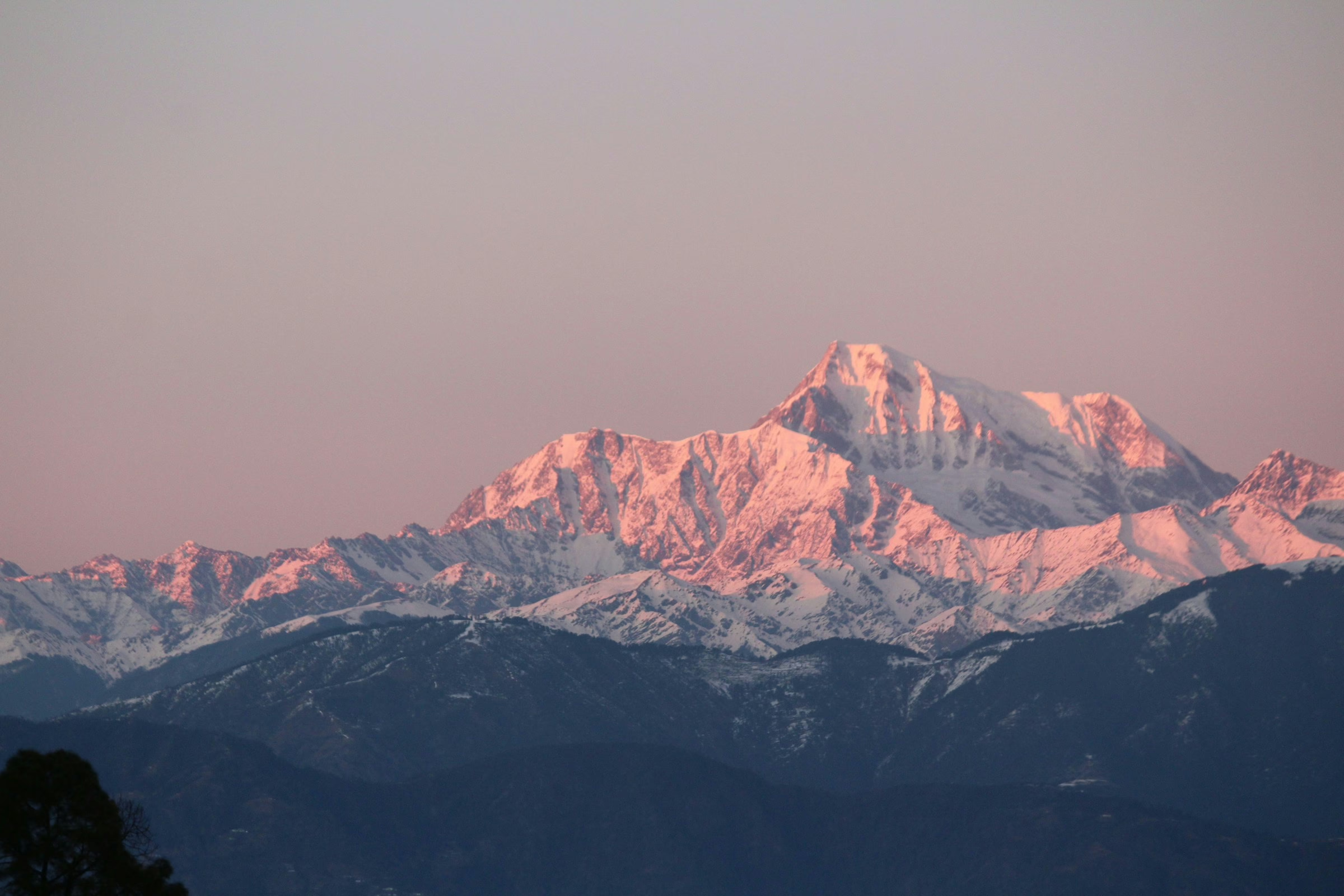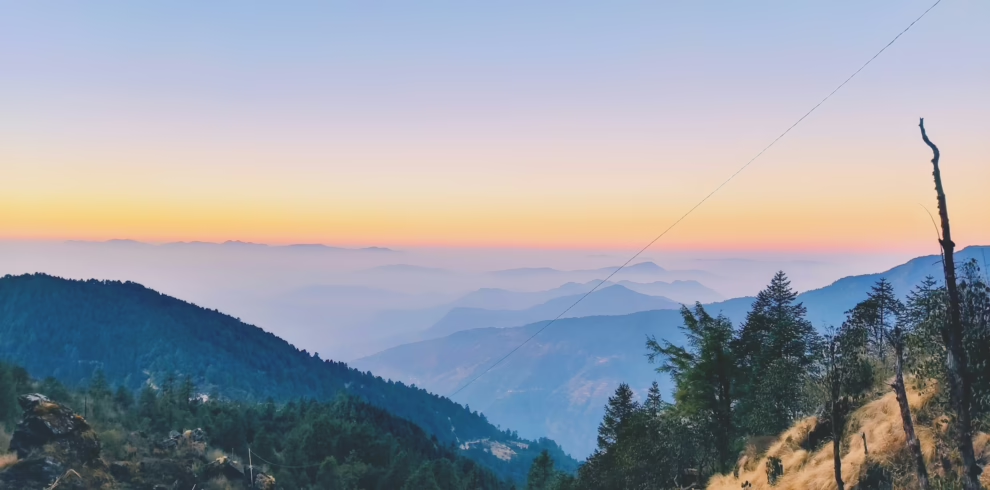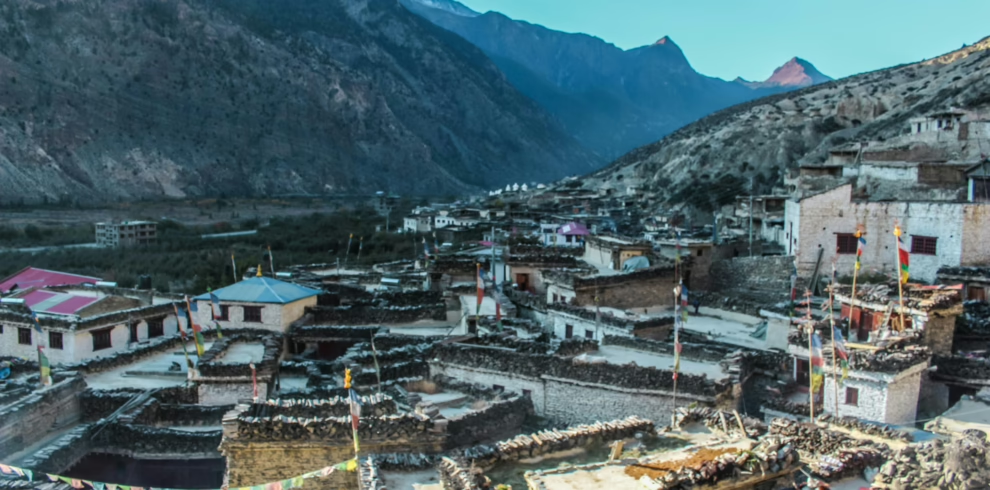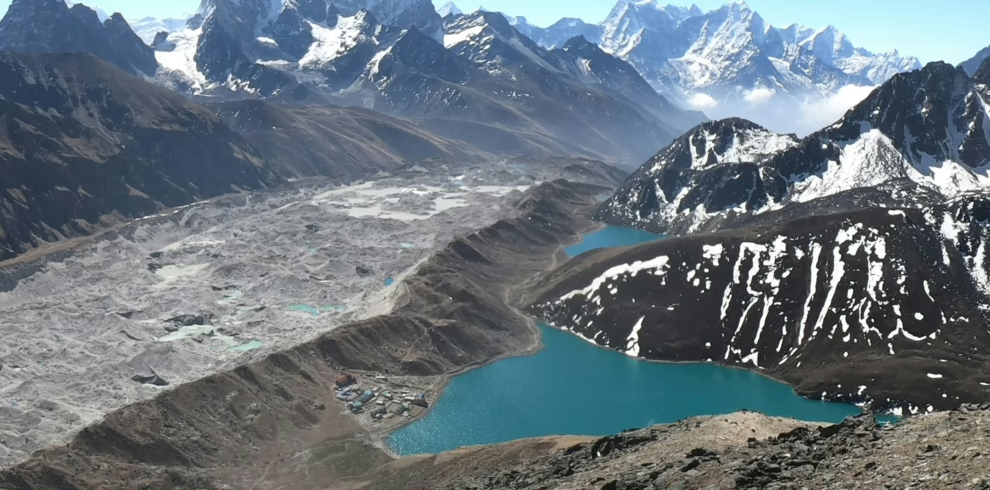Embark on a once-in-a-lifetime trek to the base of the world’s highest mountain—and do what few ever get the chance to: spend the overnight at Everest Base Camp itself.
With Green Lotus Trekking, you won’t just visit Base Camp—you’ll stay overnight in a tent at 5,364 meters, surrounded by the towering giants of the Himalayas. While most trekkers head back to Gorak Shep for the night, you’ll settle in at the foot of Everest, gaining a rare, firsthand glimpse into the life of climbers preparing for their summit push.
Imagine falling asleep at the foot of the world’s highest mountain, surrounded by ice, stars, and silence. Green Lotus Trekking proudly offers one of its most extraordinary trekking experiences—Overnight Sleep at Everest Base Camp—a rare opportunity that goes beyond the classic Everest trek.
15 days / 14 nights Overnight Sleep at Everest trip
Into The Heart of Everest Region
Highlights
- Panoramic Mountain Views: Enjoy stunning vistas of Himalayan giants, including Mount Everest, Lhotse, and Nuptse.
- Overnight at Base Camp: Sleep at Everest Base Camp (5,364m / 17,600 ft)—a rare and unforgettable experience.
- Physical Challenge: Trek through demanding terrain and high altitudes, ideal for adventurous hikers.
- Sherpa Culture: Engage with the Sherpa community and experience their rich heritage and traditions.
- Diverse Scenery: Walk through lush forests, alpine meadows, and dramatic glacial landscapes.
- Everest Base Camp Access: Stand where climbers prepare for their summit bid on the world’s tallest mountain.
- Stargazing: Witness crystal-clear night skies and catch a glimpse of the Milky Way.
- Bucket-List Adventure: A truly once-in-a-lifetime trek for nature lovers and thrill-seekers.
- Altitude Acclimatization: Carefully planned ascent with rest days to reduce the risk of altitude sickness.
- Local Teahouse Stays: Overnight in cozy, rustic teahouses offering basic comforts and warm hospitality.
- Cold Weather Ready: Prepare for chilly nights, especially at higher elevations.
Itinerary
Upon your arrival at Tribhuvan International Airport, our representative will greet you and transfer you to your hotel in a private tourist vehicle. Once you're settled at the hotel, we will schedule a trip briefing at the hotel lobby or restaurant.
During peak trekking seasons, flights to and from Lukla may operate via Ramechhap Airport to avoid air traffic congestion and delays.
Upon arriving in Lukla, you'll be awed by the towering peaks surrounding the village—just a glimpse of the journey ahead. After meeting the team, you'll begin your trek along the well-marked trail through the Dudh Koshi Valley, spending the night in Phakding.
As you follow the Dudh Koshi River, the trail ascends through pine forests toward Monjo, crossing the river at Bengkar. Upon reaching Jorsalle—the gateway to Sagarmatha National Park—you’ll be treated to stunning views of Kusum Kanguru (6,367m) and Thamserku (6,603m). After one last crossing of the Dudh Koshi and a steep final climb, you’ll arrive in Namche Bazaar, the heart of the Khumbu region. Overnight in Namche.
Today is an acclimatization day, allowing you to explore the charming village of Namche Bazaar. Visit the Sherpa Museum to learn about the culture and heritage of the Himalayan Sherpa people. For panoramic views of Mount Everest (8,848m), hike up to Hotel Everest View. You can also browse Namche’s local market to pick up supplies or comfort snacks for the trek ahead. Overnight in Namche.
The trail to Tengboche is long and dusty, but the panoramic views from the monastery make it worthwhile. With minimal steep climbs or descents, it’s an ideal day for photography. You'll pass photogenic sights such as stupas, prayer flags, Mani walls, the stunning Ama Dablam (6,812m), and the iconic Tengboche Monastery.
The trek to Dingboche begins with a crossing of the Imja Khola River. Following the west bank via Orso to Pangboche, you’ll enjoy striking views of the rising Himalayas and the valleys below. Along the way, catch glimpses of Mount Taboche (6,367m), Pokalde (5,806m), and Nuptse (7,861m) as you pass traditional mountain homes. After several hours through birch and rhododendron forests, you’ll reach Dingboche. Overnight in Dingboche.
Today is your second acclimatization day, as outlined in the Sleep at EBC itinerary. While the altitude gain rewards you with stunning views, it’s essential to rest and allow your body to adjust before continuing the trek. You can either relax or explore the area with short hikes to nearby villages like Chhukung and Imja. Popular options include trekking to Nagarjun Hill (5,100m) or Chhukung Ri (5,546m), both offering panoramic views of Mt. Makalu, Mt. Lobuche, Thamserku, Ama Dablam, and more.
The trek begins with a climb through the Khumbu Khola Valley toward Duglha, where the valley narrows near Dusa. The trail becomes more demanding due to large boulders and mountain yaks along the path. Along the way, you’ll pass memorials adorned with prayer flags and stones honoring climbers who lost their lives on Everest. The trail then connects to the route from Cho-La Pass to Gokyo Lakes. You may also catch views of peaks such as Khumbutse (6,636m), Lingtren (6,749m), and Pumori (7,161m). The rugged terrain can be tiring as you continue to Lobuche, a small settlement with limited accommodations.
The day begins with a trek along a crevasse between a glacier’s lateral moraine and a mountain slope. A gradual ascent leads to the Changri Nup Glacier, followed by an undulating trail. After a slight descent, you arrive at Gorakshep—a stark, sandy moraine dotted with lodges and surrounded by towering peaks. You'll spend the night here.
The day begins with an early morning hike up Kala Patthar ("black rock") in freezing conditions. From the summit, you'll be rewarded with sweeping views of the Himalayan giants, including Everest (8,848m), Lhotse (8,414m), Nuptse (7,861m), Ama Dablam (6,856m), Thamserku (6,608m), and Pumori (7,165m). After returning to Gorakshep, you'll continue along the Khumbu Glacier to reach Everest Base Camp—the foot of the world's highest peak. The experience is unforgettable, with awe-inspiring views of towering mountains, the Khumbu Icefall, and the glacier. You'll spend the night at Base Camp, surrounded by some of the tallest peaks on Earth.
After completing your time at Everest Base Camp, you begin the return trek through challenging terrain. Retracing your steps, you pass Gorak Shep, descend along the Khumbu Glacier to Lobuche, then continue to Dughla and cross the Khumbu River. As you approach Pheriche, the stunning Himalayan views remain a constant source of inspiration. Passing through Pheriche and Somare, you finally reach Pangboche, where you’ll spend the night.
From Pangboche, the trail descends to the Imja Khola Bridge, then continues to Tengboche. After a long descent, you reach the Dudh Koshi River and cross it via a suspension bridge at Phungi Thanga. The route then passes through the villages of Tashinga and Sanasa, with scenic views along the way. Finally, you gently ascend to Namche Bazaar (3,440m), passing Larja Dobhan.
On your final day in the Himalayas, enjoy a short downhill walk to Lukla. The trail passes through Jorsalle, where you’ll cross a suspension bridge over the Dudh Koshi River, then continue to Monjo. From Phakding, a steady climb through the Khumbu Valley leads to Lukla. Celebrate your last night in the mountains with a warm coffee or a cold beer. Overnight in Lukla.
In the morning, you'll fly to Ramechhap, then continue by road to Kathmandu. Spend your remaining time shopping in Thamel. In the evening, join the Green Lotus Trekking team for a celebratory dinner to mark the successful completion of your Everest Base Camp Sleep Trek.
A staff member will escort you to the airport for your departure. If you'd like to extend your stay, Green Valley Nepal Treks can help with arrangements. For evening flights, you may have time for some last-minute gift shopping. We hope you enjoyed your visit and look forward to welcoming you back to Nepal.
Includes/Excludes
Cost Includes
- Airport Transfers and Assistance
- Accomodation in Kathmandu: 2 nights in a standard hotel with breakfast (twin-sharing).
- Accomodation during Trekking: 11 nights in tea house lodges (twin-sharing).
- At Everest Base Camp: 1 night in tented accommodation.
- 13 Breakfasts: Options include Tibetan bread, pancakes, porridge, eggs, toast, with tea or coffee.
- 12 Lunches: Typical meals such as dal bhat (rice, lentils, vegetables), noodles, momos, fried rice, pasta, and Sherpa stew.
- 12 Dinners: Similar to lunch, plus occasional options like pizza, spaghetti, and yak steak.
- Water: Safe drinking water provided via Ef-Chlor tablets or boiled water at tea houses.
- Sagarmatha National Park Entry Permit
- Khumbu Pasang Lhamu Rural Municipality Permit
- All applicable government and local taxes
- Licensed, English-speaking trekking guide (eco-trained and first-aid certified) with a medical kit
- Staff salaries, insurance, food, accommodation, and equipment
- Round-trip flights: Kathmandu or Ramechhap to Lukla, including airport transfers
- Everest region trekking map
- Trekking poles (on request)
- -20°C rated sleeping bag
- 70–80L duffel bag (if using porter service)
- Comprehensive first-aid kit
- Emergency Support
- Staff insurance
- Assistance with emergency rescue coordination (insurance required)
- Free luggage storage at our office
- Farewell dinner at a traditional Nepali restaurant in Thamel
Cost Excludes
- International airfare
- Nepal visa fees: 15 Days – USD 30, 30 Days – USD 50, 90 Days – USD 125
- Travel Insurance (coverage must include high-altitude trekking, medical emergencies, evacuation, and trip cancellation)
- Lunch and dinner in Kathmandu
- Extra hotel nights due to early arrival, late departure, or early trek return
- Porter Service: USD 240 per porter (max 25 kg per porter)
- Personal Expenses such as hot showers, drinks, additional meals, Wi-Fi, battery charging, or upgraded rooms
- Tips for guides, porters, and staff (customary and appreciated)
FAQs
Yes, you can spend a night at Everest Base Camp as part of the trek. Note that this refers to the base camp used by trekkers, not the higher-altitude expedition base camp used by climbers attempting the summit.
Trekkers stay in designated tented camps set up for overnight stays. Teahouses and lodges are available in nearby areas like Gorak Shep but not directly at the base camp itself.
Independent camping at Everest Base Camp is generally not permitted due to regulations. Most trekkers sleep in organized tent camps or nearby teahouses arranged by trekking companies.
Yes, a high-quality sleeping bag is essential. While teahouses provide basic bedding, temperatures drop significantly at night, and a proper sleeping bag ensures warmth and comfort.
Hot showers are available at some teahouses and lodges, typically for an additional fee. Facilities are basic, and hot water access may be limited.
A good level of physical fitness is important. The trek involves long walking days at high altitudes. Cardiovascular endurance, strength, and stamina are key to a successful journey.
Alcohol is available at some teahouses, but it’s best consumed in moderation. At high altitudes, alcohol can have stronger effects and may interfere with acclimatization.
Teahouses offer basic restroom facilities, usually squat toilets. In more remote areas, outdoor pit toilets may be the only option.
Yes, if you acclimatize properly, follow your guide’s advice, and monitor weather conditions, it’s generally safe. Still, risks like altitude sickness and extreme weather exist and should be taken seriously.
With Green Lotus Trekking, the success rate is 98%. Trekkers who follow our acclimatization-focused itinerary typically complete the trek without major issues. The primary challenge is coping with altitude, which we help manage through careful planning and expert guidance.
Green Lotus Trekking offers one of its most extraordinary adventures—Overnight Sleep at Everest Base Camp. Unlike most trekkers who return to Gorak Shep after reaching Base Camp, you’ll spend the night in a tent at 5,364 meters, right at the foot of the world’s tallest mountain. Our team will transport and set up your tent and serve you a traditional Sherpa Dal Bhat meal, giving you an authentic high-altitude experience.
During spring, the prime climbing season, you may witness climbers ascending the Khumbu Icefall under the glow of their headlamps. In the quieter post-monsoon season, Base Camp becomes a peaceful, secluded place—your private window into the raw beauty of Everest, with only the sounds of the shifting glacier beneath you.
Renowned as one of the world’s best treks, the Everest Base Camp journey becomes even more unforgettable with an overnight stay at Base Camp. Since obtaining the necessary permits, we’ve successfully run this experience every year, maintaining a 98% success rate, aided by strategic acclimatization—three nights in Namche Bazaar (3,440m).
Along the way, you’ll explore the stunning landscapes of Sagarmatha National Park, home to dramatic views of Everest, Lhotse, Ama Dablam, and Thamserku. You’ll also visit welcoming Sherpa villages like Namche Bazaar, Pangboche, and Dingboche, where you’ll experience heartfelt hospitality.
Like any great journey, this trek comes with challenges. The Everest region’s rugged, icy trails and unpredictable weather demand physical endurance and mental resilience. Trekking 6–7 hours daily at high altitude can be tough, especially for first-time hikers—but those who persevere are rewarded with one of the most inspiring experiences of their lives.
Sleep is critical to success at high altitude. Proper rest boosts energy and helps the body acclimate to thin air. Without it, progress becomes difficult. Recognizing this, Green Lotus Trekking created the OvernightSleep at Everest Base Camp Trek—a thoughtful approach that prioritizes recovery, comfort, and a deeper connection to the Himalayan environment.
Benefits of Booking the Overnight Sleep at Everest Base Camp Trek with Us
- Airport pickup and drop-off
- Everest Base Camp Trek route map
- Oximeter for monitoring blood oxygen levels
- Basic medical kit for emergency use
- Free luggage storage at the Green Lotus Trekking office during your trek
What to Expect on the Sleep at Everest Base Camp Trek?
- Overnight at Everest Base Camp
The highlight of this trek is spending a night at Everest Base Camp (5,364m). Imagine lying in your sleeping bag under a star-filled sky, surrounded by towering Himalayan giants, including Mt. Everest — a moment of awe and inspiration.
- Breathtaking Scenery
The trek offers some of the most iconic mountain views in the world. You’ll pass through rhododendron forests, Sherpa villages, and dramatic suspension bridges, all framed by the rugged grandeur of the Khumbu region.
- Rich Cultural Experience
This journey isn’t just about landscapes — it’s also a cultural immersion. Visit ancient monasteries, interact with warm, welcoming Sherpas, and gain insight into their deep-rooted traditions and way of life.
- Challenging Adventure
Trekking to Base Camp is physically demanding. High altitudes, steep climbs, and unpredictable weather will test your endurance. With proper preparation and acclimatization, the challenge becomes part of the reward.
Can You Sleep at Everest Base Camp?
Yes. Even if you’re not part of a mountaineering expedition, you can still spend the night at Base Camp. While most trekkers return to Gorak Shep, we offer the rare chance to sleep in tents at EBC — something once reserved only for climbers.
Green Lotus Trekking and other operators guide trekkers from Lukla through the Khumbu Valley, eventually reaching Base Camp. Once there, you’ll stay in expedition-style tents with sleeping bags, and meals will be prepared on-site.
Why Overnight Sleep at Everest Base Camp?
Sleeping at EBC is a truly unique Himalayan experience.
- Stargazing at Altitude: With no light pollution, the night sky comes alive. Gaze at constellations, shooting stars, and the Milky Way above the towering peaks.
- Morning Views of Everest: Waking up to Everest and its surrounding giants is an unforgettable moment.
- Immersive Wilderness Experience: Being at the base of the world’s highest mountain brings a deep sense of connection to nature and adventure.
How to Prepare for the Sleep at Everest Base Camp Trek?
1. Physical Training
- Start training 2–3 months before your trek. Focus on cardio, strength, and flexibility.
- Practice hiking on inclines to mimic real trail conditions.
2. Mental Readiness
- Be prepared for physical discomfort, altitude, and tough terrain.
- Build resilience and a positive mindset.
3. Essential Gear
- Invest in quality gear: waterproof boots, warm sleeping bag, down jacket, layered clothing, trekking poles.
- Bring accessories like gloves, sunglasses, hat, and a headlamp with spare batteries.
4. Altitude Acclimatization
- Plan extra days to adjust gradually.
- Consult your doctor about altitude medication like Diamox.
5. Permits & Documents
- Obtain a TIMS card and Sagarmatha National Park permit.
- Carry waterproof copies of your passport and permits.
6. Practice Hikes
- Do shorter treks at higher altitudes to prepare your body.
7. Nutrition & Hydration
- Stay hydrated and eat a balanced diet of carbs, proteins, and fats.
- Use water purification tablets or filters.
8. Travel Insurance
- Make sure it covers high-altitude trekking and emergency evacuation.
9. Smart Packing
- Pack light — porters or yaks carry the main load.
- Keep daily essentials in a well-fitted daypack.
Useful Information for Overnight Sleeping at Everest Base Camp Trek
Safety at Everest Base Camp
At over 5,000 meters, safety is paramount. When you sleep at Everest Base Camp, we ensure both comfort and well-being. Emergency oxygen and masks are available, and our experienced guides—each with over a decade of trekking expertise—will assist you throughout. You’ll also be served nutritious, freshly prepared meals by our dedicated kitchen staff and provided with warm blankets and sleeping bags to stay comfortable through the night.
Best Time to Sleep at Everest Base Camp
The ideal seasons are spring (March–May) and autumn (September–November). These months offer stable weather, clear skies, and moderate temperatures, making them perfect for trekking and camping at Base Camp.
- Spring (Mar–May): Popular with mountaineers preparing for Everest summits. You’ll share the trail with climbers, making for a socially rich and motivational environment.
- Autumn (Sep–Nov): Offers clear views and pleasant trekking conditions. Early September may still have light rain, and late November can be colder.
Temperature Overview:
- Daytime: 10–15°C
- Nighttime: Down to -15°C (Oct: -6°C, Nov: -12°C)
With proper gear like insulated sleeping bags and down jackets, you’ll stay warm and comfortable.
Meals and Accommodation
Throughout the trek, you’ll be provided with warm meals and comfortable lodging:
- En route (Lukla to Gorak Shep): Overnight stays in teahouses, with meals included (breakfast, lunch, and dinner).
- At Base Camp: Stay in high-quality expedition tents. Meals include cereals, pancakes, soups, vegetables, rice, noodles, and more — comparable to 3-star service in this remote region.
- In Kathmandu: Stay in a 3-star hotel with breakfast included. Meals during your time in the city are not included in the package
Trek Difficulty
The Overnight Sleep at Everest Base Camp Trek is rated moderate to challenging:
- Easy segments: Lukla to Phakding and Namche Bazaar offer well-maintained paths.
- Challenging sections: Lobuche, Gorak Shep, and Base Camp involve higher altitudes and steeper terrain, with lower oxygen levels contributing to fatigue.
Despite the challenge, our team ensures comfort at every stage, including freshly prepared meals and expert support at Base Camp.
Travel Insurance Requirements
Travel insurance is mandatory for this trek. It must cover:
- High-altitude trekking
- Emergency evacuation by helicopter
- Medical treatment
Carrying proof of insurance is required. In emergencies, helicopter evacuation is the only viable option, so reliable coverage ensures peace of mind.
Altitude Sickness & Prevention
Symptoms may include headaches, dizziness, nausea, and shortness of breath. While some mild discomfort is common, serious symptoms must be addressed immediately.
Tips for Prevention:
- Stay hydrated with warm fluids
- Eat regularly
- Avoid alcohol and caffeine
- Acclimatize properly
- Bring Diamox (consult your doctor)
If symptoms worsen, your guide will arrange medical support or helicopter evacuation if necessary. Supplemental oxygen is available at Base Camp if needed.
Safety Equipment
We take every precaution to ensure your safety at Base Camp:
- Bottled oxygen and first aid
- Warm sleeping bags and insulated tents
- Campsites located away from avalanche zones
- Secure logistics and emergency response plans
Our experienced guides and porters will accompany you at all times. Porters carry up to 15 kg of luggage. You should keep essential items such as passports, cash, phones, and electronics with you in a daypack.

